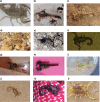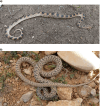The role of social media in public health awareness during times of war in Sudan: snakebites and scorpion stings
- PMID: 38956503
- PMCID: PMC11218301
- DOI: 10.1186/s12889-024-19156-8
The role of social media in public health awareness during times of war in Sudan: snakebites and scorpion stings
Abstract
Background: Snakebite envenomation (SBE) and scorpion sting envenomation (SSE) are significant neglected tropical diseases that primarily affect impoverished communities in rural areas of developing nations. A lack of understanding about snake and scorpion species and their distribution exacerbates the disabilities and fatalities caused by SBE and SSE. In Sudan, particularly in regions affected by ongoing conflicts where healthcare resources are scarce, social media platforms offer a cost-effective approach to addressing public health challenges. Our aim in this study is to highlight the benefits of using social media for data collection and health promotion in such environments.
Methods: We present a cost-effective communication and data collection strategy implemented at the Toxic Organisms Research Centre (TORC) of the University of Khartoum, focusing on a Facebook group, "Scorpions and Snakes of Sudan", as our primary social media platform. Additionally, we discuss the lessons learned and the initial impact of this strategy on enhancing population health literacy.
Results: The group community is composed of ~ 5000 members from 14 countries. During the period from January 2023 to January 2024, we received 417 enquiries about snakes and scorpions belonging to 11 families and composed of 55 species. In addition, 53 other enquiries covered a range of organisms and their tracks (e.g., spiders, skinks, chameleons, foxes, sun spiders, centipedes, lizards, moth larvae, and insect tracks). The first photographic evidence of Malpolon monspessulanus in Sudan was via the group activities. The rare species Telescopus gezirae, the Blue Nile cat snake, is also documented via the group member's queries. Recognizing the evolving nature of social media use in public health, we also address the current limitations and evidence gaps that need to be addressed to effectively translate best practices into policy.
Conclusion: In conclusion, utilizing Facebook as an institutional platform to share scientific information in simple Arabic language underscores the proactive roles that citizens, scientists, and public health stakeholders can play in leveraging social media for eHealth, eAwareness, and public health initiatives. This approach highlights the potential for collaborative efforts, particularly during crises, to maximize the benefits of social media in advancing public health.
Keywords: Citizen science; Data; Envenomation; Facebook; Identification kits; Scorpions; Snakes; Social media; Species conservation through positive cultural change; Sudan; e-Awareness; eHealth.
© 2024. The Author(s).
Conflict of interest statement
The authors declare no competing interests.
Figures















Similar articles
-
Knowledge and perceptions of snakes, snakebites and their management among health care workers in Sudan.PLoS One. 2024 Sep 20;19(9):e0302698. doi: 10.1371/journal.pone.0302698. eCollection 2024. PLoS One. 2024. PMID: 39302983 Free PMC article.
-
Medically important snakes in Sudan: an overview of distribution, clinical features and present challenges.Trans R Soc Trop Med Hyg. 2025 May 1;119(5):541-549. doi: 10.1093/trstmh/trae063. Trans R Soc Trop Med Hyg. 2025. PMID: 39749548 Review.
-
Venomous snakebites: Rapid action saves lives-A multifaceted community education programme increases awareness about snakes and snakebites among the rural population of Tamil Nadu, India.PLoS Negl Trop Dis. 2020 Dec 31;14(12):e0008911. doi: 10.1371/journal.pntd.0008911. eCollection 2020 Dec. PLoS Negl Trop Dis. 2020. PMID: 33382715 Free PMC article.
-
Treatment of snake, insect, scorpion, and spider bites in the pediatric emergency department.Curr Opin Pediatr. 1996 Jun;8(3):256-60. doi: 10.1097/00008480-199606000-00012. Curr Opin Pediatr. 1996. PMID: 8814404 Review.
-
Assessment of knowledge about first aid methods, diagnosis, and treatment of scorpion stings among health workers in Ouarzazate region, Morocco: A cross-sectional study.Toxicon. 2024 Nov 6;250:108085. doi: 10.1016/j.toxicon.2024.108085. Epub 2024 Aug 30. Toxicon. 2024. PMID: 39216795
Cited by
-
Preventive practices and parental attitudes towards snakebites in children in snakebite hotspots of rural Sri Lanka.BMJ Paediatr Open. 2025 Jun 13;9(1):e003543. doi: 10.1136/bmjpo-2025-003543. BMJ Paediatr Open. 2025. PMID: 40514225 Free PMC article.
-
Stroke as a rare complication of scorpion stings: A systematic review and analysis.Toxicon X. 2024 Aug 30;24:100205. doi: 10.1016/j.toxcx.2024.100205. eCollection 2024 Dec. Toxicon X. 2024. PMID: 39290877 Free PMC article. Review.
References
-
- WHO. Snakebite envenoming, World Health Organization, 12 September 2023. [Online]. Available: https://www.who.int/news-room/fact-sheets/detail/snakebite-envenoming. [Accessed 21 February 2024].
-
- El-Aziz F, El Shehaby D, Elghazally S, Hetta H. Toxicological and epidemiological studies of scorpion sting cases and morphological characterization of scorpions (Leiurusquin Questriatus and Androctonus crassicauda) in Luxor, Egypt. Toxicol Rep. 2019;6:329–35. doi: 10.1016/j.toxrep.2019.03.004. - DOI - PMC - PubMed
MeSH terms
LinkOut - more resources
Full Text Sources
Research Materials
Miscellaneous

